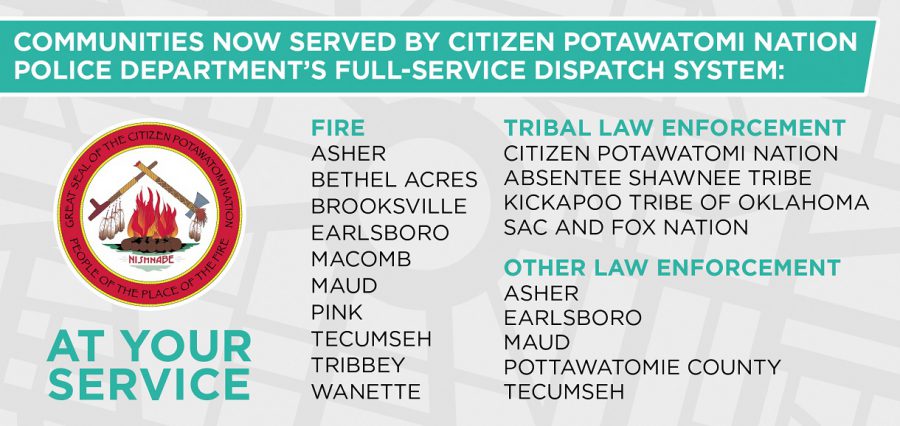
As upgrades to Citizen Potawatomi Nation’s police and emergency dispatch system expand, so do benefits to more than 40,000 Pottawatomie County residents and nearly a dozen fire and police agencies, with plans for continued growth.
May 19, 2013, a catastrophic long-track EF-4 tornado swept through Lake Thunderbird, Bethel Acres and Shawnee, Oklahoma.
“It hit Bethel Acres very hard,” Brian Scott, Citizen Potawatomi Nation law enforcement grant administrator, said of the twister. “We quickly realized the communications system for Pottawatomie County was insufficient for our needs. When we had a major disaster scenario, it became oversaturated and was incapable of supporting all of the needs of the agencies that relied upon it.”
Jody Opela is the Major of patrol and oversees CPNPD’s 911 center. He, Scott and others established a new, countywide dispatch service called OMACS, or Oklahoma Multi-Agency Communications System.
“We built the tower and moved all of Pottawatomie County off of Shawnee’s provider,” which is Oklahoma Wireless Information Network (OKWIN), Opela said.
Citizen Potawatomi Nation is a leading partner in the OMACS initiative, which is a collaboration between Oklahoma City’s Stolz Telecom, Tribal Nation first responders, and county and local government agencies, including fire and police departments.
Scott said that, during the 2013 storm and its immediate aftermath, “I had 18 officers on duty — I had more officers on duty than the Pottawatomie County Sheriff’s Office, Absentee Shawnee police, Kickapoo tribal police, Sac and Fox police — all of those agencies combined.
“I couldn’t talk with any of them,” he said. “Anytime I keyed up, we got a busy signal.” OMACS changes that. “In our system, the whole thing is a priority,” Opela said of the Tribe-developed East Central Oklahoma Emergency Communications Network (ECOECN), part of OMACS. Previously, “it was a loading issue. When the tornadoes hit, OKWIN partners could talk but not other users.”
Officially, the Tribe’s network is ECOECN, Scott said, and laughed. “We use lots of acronyms.”
For the uninitiated, the acronyms can be tricky to follow. Essentially, CPN formed a localized, full-service dispatch and emergency response network that now helps Pottawatomie County serve more than 40,000 residents outside of the city of Shawnee.
“The only way to fix the system was to fix it all,” Scott said.
Day-to-day, it won’t work much differently than the prior dispatch network provider.
“What’s important is the fact that some agencies still use OKWIN, some agencies use OMACS, and it creates additional capacity,” he explained.
“Like in a house — if you have 18 things plugged into an outlet, you’re going to blow a breaker. Our system is like installing another circuit in there that allows you to distribute the load,” during emergencies, he said. “That’s what is critically important to allowing us to do this.”
Phase one
“The first stage was to upgrade our dispatch, which was largely done with funds from the Department of Justice acquired through a CTAS grant,” Scott said of the Coordinated Tribal Assistance Solicitation funds.
As part of phase one, Pottawatomie County transferred its 911 system to the Tribe. This meant designing a new radio system for the county, which was funded by the Department of Homeland Security through a FEMA THSGP (Tribal Homeland Security Grant Program) grant, Scott said.
“With that funded, we established a radio network backbone — the server system and a repeater co-located on a cellphone tower south of Tecumseh,” Scott said.
Phase one is complete. Dispatch upgrades cost around $250,000 and the tower backbone around $700,000, Opela said.
“Every one of these calls rolls through our 911 center,” he said. “That’s all calls — your cat’s up a tree, everything … with the ability to reach about 100 first responders in these communities.”
The Tribe upgraded to open-source technology instead of proprietary, which also lowers equipment, maintenance and other costs. Also, a clear-cut local agency is responsible for maintenance, upgrades, upkeep and cost increases for each tower location.
OMACS, with the Nation’s ECOECN, now serves tribal law enforcement dispatch for the Nation, Absentee Shawnee Tribe, Kickapoo Tribe of Oklahoma and Sac and Fox Nation.
It also provides fire and law enforcement dispatch for Asher, Earlsboro, Maud and Tecumseh, and fire department dispatch for Bethel Acres, Brooksville, Macomb, Pink, Tribbey and Wanette.
“The agencies were paying dispatch fees, but now CPN dispatches for those communities for free,” Scott said, which saves Tecumseh agencies around $70,000 and Pottawatomie County nearly $80,000 annually.
Phases 2, 3 and ‘3.5’
“We’re fixing to break ground on another tower near McLoud,” Opela said.
As part of ECOECN and, by default, OMACS, phase two includes an eight-channel repeater and finishes phase two of CPN’s dispatch upgrade.
“We’ll put the last and final tower somewhere between Wanette and Asher,” to complete phase three, Opela said.
In what Opela called “phase 3.5,” the Tribe will install mobile repeaters in a giant emergency communications truck donated by FEMA. Altogether, these projects will cost a little more than $1.5 million, paid for with federal grants and by the Tribe.
“That was the truck that actually responded to the Murrah Building bombing,” he said, referencing the 1995 domestic terrorism attack in Oklahoma City. “If you watch footage, this is the big truck with all the communications that was at the Murrah building.
“We’re going to bring it back up to full operations. That way, if we have outages in areas, we can roll the truck out there, stand the mast up, turn the repeaters on and light it up again.”
Opela added, “Now, instead of one system with multiple partners and affiliates in it, each agency has its own equipment and collaborates. We’re working to make sure we’re prepared for the next major emergency.”
